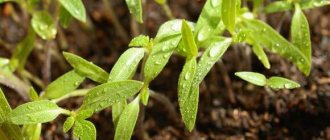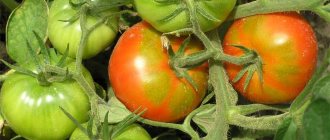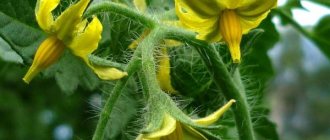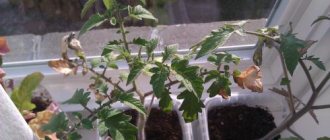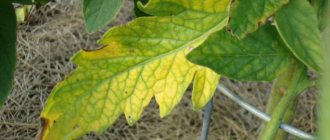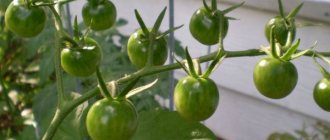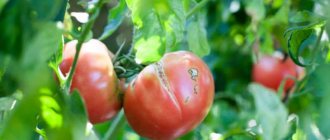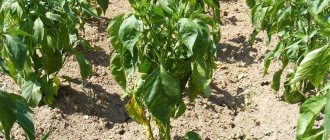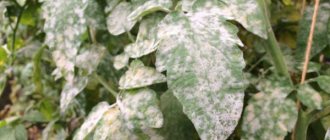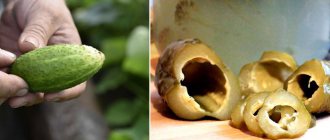Agricultural crops, for the most part, are very unpretentious, but not tomatoes. The plant is very demanding on moisture levels, soil, and light. If any growing conditions are violated, tomatoes begin to get sick, then wither and eventually die.
One of the most common problems is leaves drying out at the edges. Most gardeners encounter this problem, and by the time you finish reading, you will know what to do to prevent leaves from drying out.
Characteristics of tomato culture
Belonging to the nightshade family, tomatoes are a herbaceous plant with a stem reaching a height of 0.3 m to 2 m, and a root system that can go deeper than 1 m. The odd pinnate dark green leaves often resemble potatoes; the yellow flowers are inconspicuous in appearance. appearance, but the fruits in the form of berries of different sizes look impressive when colored in numerous shades of red, as well as yellow, white, green and even black.
The weight of tomatoes varies from 50 to 800 g. Tomatoes are one of the most popular vegetable crops. At the same time, they are considered one of the most capricious vegetables, requiring strict adherence to agrotechnical rules and great care when caring for them.
Did you know? The authority of botanical scientists classifying tomatoes as berries was not enough for the US Supreme Court, which by its decision condemned tomatoes to be considered vegetables. More
«
further
»
The European Union went ahead and classified tomatoes as fruits.
Damaged roots
You may suspect that the plant's rhizome is in danger if only the lower leaves have changed. Otherwise, the tomato has a blooming appearance.
Probably, the damage occurred due to the fault of the gardener, who handled the tomato carelessly, using the hoe too actively. The rhizome consists of an elongated central root, with the help of which the plant absorbs moisture from the bottom of the soil during drought, and a cluster of small feeding roots at the very top of the underground layer. When weeding the soil, gardeners often touch this system.
Mulching technique
To protect the layer, you can use the mulching technique, then during loosening the chances of touching the rhizome will be significantly reduced. In the meantime, you will have to wait for the damaged elements to grow back and the tomato to recover. But there’s nothing you can do about the leaves—you can only tear them off if the tomatoes turn yellow and dry out.
The main reasons for tomatoes drying out in a greenhouse
The sources of such troubles for tomato plantings in a greenhouse are, as already mentioned, non-compliance with agrotechnical methods of cultivating the crop and the associated detrimental effect on weakened plants from diseases and pests.
Violations of crop care rules
The main agrotechnical methods for caring for tomatoes in the form of fertilizing, watering and ensuring optimal illumination can lead to serious consequences if they are violated:
- Excessive feeding of tomatoes with organic fertilizers often leads to an imbalance of nutrients in the soil. As a result, an excess of nitrogen and a deficiency of phosphorus, potassium and zinc provoke leaf curling on tomato bushes and their subsequent drying out. In addition, fertilizing with organic matter in the form of manure causes active release of ammonia, which can cause burns to tomato foliage.
- Although tomatoes are a moisture-loving crop, excessive watering can cause significant damage to them, also leading to curling of the foliage and its death.
- Being at the same time also a heat-loving crop, tomatoes do not tolerate excesses in this regard, reacting to excessively high temperatures by drying out the leaves and killing the plant. This occurs at an ambient temperature of +35°C and above.
- Another reason for the drying out of a tomato plant can be a lack of illumination during short daylight hours.
Did you know? Unlike most plant fruits, during heat treatment, tomatoes do not lose, but, on the contrary, acquire beneficial properties. In the refrigerator, on the contrary, they lose their beneficial properties - again, in contrast to most other plant products.
Pests and diseases
Plants weakened by improper care are most susceptible to attacks by pests and pathogenic infections. This is especially evident in diseases:
- fusarium wilt, which spreads especially actively when there is an excessive presence of nitrogen in the soil and with excessive watering, as a result of which tomato leaves dry out;
- late blight, the appearance of which is provoked by excessive watering and incorrect temperature conditions, which leads to damage to foliage and fruits.
Plants weakened by improper care become easy prey for pests in the form of:
- aphids, which sucks the life juices out of the plant and leads to its drying out;
- whiteflies, whose larvae destroy the green mass of tomato bushes and cause the plants to completely dry out;
- spider mite, slowly but surely causing yellowing of the leaf surface and its death.
Cladosporiosis
Brown spot or cladosporiosis most often affects tomatoes grown in winter greenhouses. The source of the disease is neighboring plantings, last year's plant debris, contaminated soil or seeds.
Symptoms of cladosporiosis:
- The plant wilts with sufficient watering.
- Yellow streaks or spots appear on the upper side of the leaves.
- The bottom of the tomato leaf is covered with a brown coating.
- Affected leaves darken and curl over time.
- The ovary or unripe tomatoes lose their juiciness and dry out.
What to do first when cladosporiosis is detected:
- Weed the tomatoes and clear the beds of vegetation.
- Cut and then burn diseased shoots.
- Treat the bushes with fungicides or preparations based on copper compounds.
Possible solutions to problems
Accurate and timely determination of the reasons causing the drying out of tomato bushes allows you to effectively and quickly eliminate the problem:
- In case of unbalanced feeding with excess nitrogen and deficiency of potassium, phosphorus and zinc, it is necessary to abandon organic fertilizers and saturate the soil with mineral fertilizers containing the missing elements.
- Excessive soil moisture must be corrected by more moderate watering once a week, increasing its intensity to 2 times a week during fruiting and pouring up to 4 liters of water under each bush, which must be settled and at a temperature not lower than +24°C. It is necessary to water tomatoes at the root.
- Excessively high temperatures in the greenhouse are eliminated by ventilation and shading of plants using lutrasil. In this case, it is necessary to proceed from the fact that the daytime temperature in the greenhouse should be within the range of +23...+25°C, and the night temperature should drop to +16...+18°C.
- A lack of illumination, leading to drying out of plants, occurs when growing tomato seedlings during a period with short daylight hours. To eliminate this problem, artificial lighting is required, which can provide tomatoes with daily daylight of up to 16 hours.
- All these measures, carried out in a timely manner, can effectively eliminate the problems that have arisen. Stronger plants will no longer dry out and will be able to resist diseases and pests.
Important! Tomato bushes already affected by the disease should not be saved. They must be promptly destroyed and the soil underneath them disinfected.
Illiterate feeding
Why do tomato leaves wither? Often the cause is an improperly organized diet. In this case, the problem is caused by both a deficiency and an excess of one or another element.
First of all, you need to determine which leaves are affected by the problem.
- If old leaves on tomatoes turn yellow, they are lacking nitrogen, phosphorus, potassium, magnesium, zinc or molybdenum.
- If the top shoots of tomatoes wither and turn yellow, then they do not receive enough calcium, chlorine, boron, sulfur, manganese or iron.
Wilting of leaves due to a lack of one or another nutrient is easily treated. To do this, regulate the application of necessary fertilizers.
Nitrogen
The lack of nitrogen in sufficient quantities leads to the fact that tomatoes do not grow and remain small with sparse foliage. The veins on the leaves turn crimson, then gradually the entire leaf turns yellow and withers. To correct the situation, tomato beds are watered with a urea solution prepared at the rate of 30 g of fertilizer per 10 liters of water.
Phosphorus
A lack of phosphorus is manifested by the purple color of the plant's foliage, hard and brittle stems. Ignoring such signals leads to the death of the roots. To prevent this from happening, pour 1 tsp under each plant. superphosphate for proper growth.
Potassium
If young leaves, twisted into tubes, appear on the tops of the tomato beds, and the old ones have turned yellow and dried out, the plantings are fed with potassium fertilizers. A sufficient amount of potassium helps sprouts resist various diseases. The use of a solution of 40 g of potassium sulfate per 10 liters of water restores the balance of the microelement in tomato beds.
Magnesium
During the growing season, tomato sprouts really need magnesium. Its deficiency is manifested by yellowing of the foliage between the veins. After this, the entire sprout withers. Magnesium deficiency is corrected by spraying the beds with a solution of magnesium sulfate at the rate of 5 g per 10 liters of water.
Zinc
Small yellow spots on young leaves of the vegetable indicate a lack of zinc in tomatoes. To replenish this element, gardeners dilute 5 g of zinc sulfate in 10 liters of water. The prepared solution is sprayed onto the plants.
Molybdenum
Light green leaves with yellow speckles and upturned edges indicate an insufficient amount of molybdenum. This element is responsible for the process of chlorophyll production. It is better to take care of eliminating the problem in the fall. The soil in future beds is limed, and fertilizers containing phosphorus are used. If the problem occurs to the tomatoes after transplanting them to a permanent location, foliar feeding should be done with a solution of ammonium molybdate prepared at the rate of 10 g of fertilizer for every 10 liters of water.
Calcium
Yellowed tops may indicate calcium deficiency
Yellowed and wilting tops of leaves in tomato beds indicate damage to the root system or structure of tomatoes in general. This is caused by a lack of calcium. 5 g of calcium nitrate diluted in a bucket of warm water will help replenish its reserves.
Iron
A lack of iron leads to chlorosis of the leaves. This phenomenon rarely occurs when cultivating tomatoes. This happens if the soil in the beds is oversaturated with lime. To replenish reserves of this element, the soil is treated with iron sulfate. A solution is prepared from 5 g of the drug for every 10 liters of water.
Chlorine, sulfur and others
Lack of chlorine is manifested by the death of young leaves and shoots. With a lack of sulfur, the leaves become like newsprint. Boron deficiency is manifested by wilting of the tops. With a lack of manganese, tomato leaves first become brightly colored, then wither, dry out and die.
To restore the balance of these nutrients, tomato plantings are treated with special preparations that contain the listed substances. Solutions are prepared following the dosage: 5 g of microelements per bucket of water.
Preventive measures
The best prevention of drying out of tomato bushes and other similar problems, as has been repeatedly emphasized, is scrupulous adherence to agrotechnical rules for growing tomatoes. In addition to this it is useful:
- Collect seeds only from fruits grown on healthy plants.
- Treat tomato seeds before sowing them in the ground.
- Strictly observe crop rotation, planting tomatoes in the same place no earlier than after 3 years.
- Disinfect the soil before planting seedlings using copper sulfate, for which 70 g of the drug is dissolved in a bucket of water.
- Disinfect the greenhouse itself.
- In order to create a balanced saturation of useful substances in the soil, it is necessary not only to limit the use of organic matter as fertilizers, but also to saturate the soil using the liquid preparation “Effecton-O”.
- Be sure to destroy tomato tops after harvesting.
Hypothermia
Even covering plants with fabric or film will not save them from the cold when growing in open ground. Therefore, observe the timing of planting seeds specifically for your region, plant in greenhouses and hothouses, and use early-ripening varieties.
Signs
If the tomatoes still managed to suffer from the influence of low temperatures, this will be noticeable by the following signs:
- growth slowdown;
- widespread yellowing of leaves;
- border that has become bluish;
- redness of the stem in some cases.
You can try to save the fruits by spraying with adaptogens like aloe or zircon - just one drop per liter of water is enough.
Useful tips from vegetable growers
Answering the question of what to do to ensure that tomatoes grow without problems and produce a good harvest, experienced vegetable growers recommend:
- Regularly hill up tomato bushes so that the soil rises above the root collar by at least 10 cm.
- To create optimal moisture in the soil, it should be mulched with dry sawdust, hay or crushed peat.
- In hot weather, water tomato bushes in the evening, when the root system absorbs moisture best.
- During artificial lighting in the greenhouse, lay foil or white paper on the floor, whose reflective properties significantly increase the illumination of the room.
- When ventilating the greenhouse, direct the air flow along the top and middle parts, since the movement of air below dries out the soil excessively.
Important! In no case should you plant tomatoes where potatoes were previously cultivated, since they, being a close relative, are susceptible to the same diseases, contaminating the soil with their pathogens.
Given the variety of reasons that cause tomato bushes to dry out in a greenhouse, they all, in most cases, come down to improper agricultural practices for cultivating the crop. Exactly following the simple rules of proper care for it can radically put an end to this problem.
Insufficient lighting
With insufficient light supply to tomato bushes, the foliage begins to shrink, lose its elasticity and firmness, yellow spots appear, the leaves dry out first at the tips, then completely, and as a result fall off. At the same time, the side branches of the tomatoes from the stem grow in length and become thinner at the top. The stage of formation of inflorescences in the plant begins to slow down or does not begin at all.
Fighting methods
Coping with the situation in this case is quite easy: you just need to eliminate the cause of the lack of lighting:
- if tomatoes are grown in a greenhouse, light can be added by placing additional artificial sources,
- if tomato bushes are planted in an insufficiently lit area in an open garden bed, you can remove closely spaced bushes and trees that block sunlight,
- if it is impossible to create conditions for additional lighting by cutting down on unprotected ground, some resort to little tricks by installing reflective panels made of plywood sheets and covered with foil, or use mirror surfaces and foil insulation.
Withering and curling due to lack of trace elements
Curled tomato leaves may indicate a lack of some micronutrient. Most often, tomatoes lack phosphorus and potassium. If there is a lack of phosphorus, the leaves curl down, move away from the stem at an acute angle and may turn dark green or acquire a purple tint.
Potassium deficiency is manifested by leaves curling upward from the edges to the middle, young leaves become curly, and ripe tomatoes may have light spots.
Here our helpers will be feeding. Ash will help supporters of organic farming. For those who use mineral fertilizers, superphosphate and potassium nitrate are available.
Insect damage
The reason why tomato leaves curl and turn yellow may be insect pests. By carefully examining young foliage, they can be easily detected. Black aphids settle on leaves, stems and petioles. Mole crickets and wireworms destroy tomato roots. The whitefly feeds on plant sap. You need to know what to do if tomato leaves turn yellow in a greenhouse due to an insect invasion, and what protective measures should be used.
Medvedka
The insect often attacks garden crops, gnawing on their roots. If a mole cricket gets into a greenhouse, tomatoes become its victims. She chews through the stems and tears out the roots.
Tomatoes stop developing, the leaves turn yellow, and the plants may die. Despite its underground lifestyle, the mole cricket is capable of swimming and flying over considerable distances. Birds are not scary for her, since the insect is active only at night. It is especially common in loose, humus-rich, well-manured soil.
Fighting a mole cricket is quite difficult. The approach should be comprehensive, including several methods simultaneously. It is good when the fight against insects is carried out in neighboring areas, since there are no barriers for the insect. Among the main methods of destroying or repelling the pest:
- manure traps;
- shadow baits;
- planting marigolds;
- repelling with strong odors (garlic, missing fish, onions);
- adding ash and eggshells to the hole when planting;
- use of chemicals (“Thunder”, “Medvetox”, “Grizzly”).
Granules of the preparations are laid out when planting seedlings in a greenhouse.
Important! Chemicals are strong poisons. When using them, safety precautions must be observed.
Wireworm
The worm-like larva of the click beetle, about 3 cm long, is called a wireworm.
It has a hard, shiny brown body. In winter, it burrows into the soil to a depth of 50 cm. For three years, the larvae grow and feed intensively, and in the fourth year they make a burrow and pupate. In April, beetles hatch from the pupae, fly out and lay eggs, from which a new army of wireworms emerges.
The pest eats flowers, gnaws the stems and roots of tomatoes, and they gradually turn yellow and dry.
Important! It is believed that the wireworm does not touch tomatoes of dark raspberry and pink varieties.
Pest control comes down to agrotechnical practices and the use of chemicals:
- destruction of weeds (wheatgrass and burdock);
- loosening the soil;
- growing mustard, rapeseed, buckwheat, spinach on the plot;
- making traps
- reducing soil acidity in the greenhouse;
- the use of insecticides (Bazudin, Kapkan, Karate, Metarizin, Diazinon).
Important! All chemicals are used only if the dosages are strictly observed, so as not to have a strong toxic effect on the soil, crops and the human body.
Nematode
A 1 mm long worm, a pest of tomatoes and other vegetable crops, is called a nematode.
In a greenhouse with tomatoes, it forms nodules on the roots. The plant turns yellow, lags behind in development, looks depressed and later dies. The pest can only be detected by digging up the bush. The first sign of nematode damage is the wilting of the plant during the day, in sunny weather. After some time, the roots of the damaged bushes turn green and “crawl” to the surface.
The pest is very dangerous. At the first signs of damage, the plants are dug up and burned, and the soil is spilled with boiling water. In the fall, the greenhouse is sown with grain crops, and before frost, it is dug up, embedding the seedlings in the ground. Under such conditions, the nematode freezes out.
To combat the pest, the chemicals Lindane, Methyl Bromide, and Nemagon are used.
Among biological agents, the drugs “Nematophagin”, “Fitoverm P”, “Trichodermin” have the most powerful effect.
Important! Biological agents are slightly toxic to humans. The effect on pests is their paralysis and death.
Tobacco aphid
Tobacco, or peach, aphids appear on tomatoes if there is a peach orchard next to the greenhouse. The pest overwinters in the buds of fruit trees. In the spring, aphids migrate to tomatoes, and at the end of summer they return back to winter.
Aphids attack young tomato foliage, shoots, buds and flowers. Feeding on the plant, the pest sucks the juice from the leaves, which turn yellow, curl, and become deformed. In addition to the harm caused by their vital activity, aphids carry fungal and viral diseases.
To destroy tobacco aphids on tomatoes in a greenhouse, chemical agents are used: “Biotlin” (destroys adult individuals and their eggs), “Akarin” (contact-intestinal action), “Iskra” (broad-spectrum agent).
Among the most commonly used folk remedies:
- soap-ash solution;
- garlic infusion;
- celandine decoction.
Lack of moisture
Lack of moisture leads to many problems, but the leaves are the ones that suffer first.
Signs of a problem:
- At first, the foliage begins to fade a little . The stems become soft, the tops and ends of the shoots droop and lose their elasticity.
- Over time, the foliage begins to curl . Then it turns yellow, and at the most advanced stages it turns black and falls off.
What to do:
| Water the plant generously At the first sign of a lack of moisture, you need to moisten the soil well. At least 20 liters are poured under each large bush. If the plant is not tall, then the soil is saturated to a depth of at least 30 cm. Use only warm water . It is advisable to leave it for a day so that the temperature is the same as the air temperature. Cold water is an additional stress for plants and the risk of disease. | |
| Water frequently if necessary If you watered the seedlings often and with small amounts of water, then it developed upper suction roots. Therefore, the plant gets used to collecting moisture from the surface, and the deep roots almost do not participate in this. The problem can only be solved by frequent moderate watering . The plant can absorb water well only in this way, so there is no other way out. In this case, it is very important to loosen the surface to reduce the evaporation of moisture from the soil. | |
| Use a drip irrigation system This option provides a constant supply of water under the tomato trunk. The plant is constantly moistened in the required quantities, so the risk of moisture deficiency is minimal. It is best to install the system immediately after landing . This is how plants adapt to a certain regime and absorb moisture as efficiently as possible. |
Reviews from gardeners
Vadim, Astrakhan
The meaning of the root is quite weak for such a leaf. In my situation, I removed something from the leaves from below (at least slightly reduce the leaf apparatus). I had Quadris on hand (which enhances photosynthesis as a side effect) and Aktara (which also enhances root development as a side effect) - I gave it a drop at a time...that’s all.
Source: fermer.ru
Alevtina, Khimki
You need to increase fertilizing with potassium: ash or potassium sulfate. Sprinkle ash under the plants, spray/water with ash extract or a solution of the mentioned potassium sulfate 1 tbsp. spoon for 10 liters - 1 - 1.5 liters per plant. Excess potassium is not dangerous either for plants or for us.
Source: www.forumhouse.ru
Leaves turn yellow and dry out
If the leaves of tomato seedlings dry out and turn yellow immediately after picking, then it is quite possible that the roots were damaged during replanting. This happens with early or careless picking. Let's list what other reasons there may be for the leaves turning yellow and drying out at the time of picking seedlings:
- fungal disease;
- sunburn;
- “wrong” soil mixture.
As a rule, manufacturers of soils for seedlings sin in the same way. They put too much peat and don't add any microelements at all. But during this period, seedlings vitally need nitrogen and other substances. Sometimes purchased soil consists entirely of peat, and the water does not linger and flows into the pan. Moisture does not reach the roots of the seedlings.
Self-preparing the seeds and soil before sowing will help eliminate the cause, which will help avoid contamination of the soil with diseases such as fungus. To prevent diseases, seeds for sowing can be treated in a saturated solution of manganese
And then, taking precautions, change the water in which they will be soaked, rinse the dishes to avoid fungal diseases
The soil mixture needs to be heated for 10-20 minutes in an oven preheated to 200°C. It will be better if you prepare the soil for tomato seedlings yourself. To do this, you need to mix several ingredients, which are taken not by weight, but by volume. One of the compositions:
- turf soil - 3 parts;
- compost - 2 parts;
- sand - 1 part.
In order to properly prepare the soil for tomato seedlings, you need to mix all the ingredients in the fall. In winter, place the container with soil on the balcony so that the main causes of disease - fungal spores - die.
In the spring, before planting, the mixture must be sifted or large particles must be manually removed. Add 2 tablespoons of superphosphate, a liter of ash and a bag of vermiculite to a bucket of tomato mixture. Often the cause of poor soil is too little air. Vermiculite will give it lightness and saturate it with air.
But, in growing tomatoes, other reasons may appear, as a result of which the leaves will begin to turn yellow, dry out, and a disease may even develop. To prevent this from happening, you need to know the reasons and know what to do with tomato seedlings. These may include the following reasons:
- flooding with water (excessive watering);
- lack of light;
- lack of nitrogen.
Let's look at each point separately. Overwatering of seedlings is a common problem among gardeners. It's not always their fault. It happens that the soil is formed incorrectly and it either strongly “holds” water, or, conversely, allows it to pass through. In this case, the leaves begin to turn yellow and dry out. In such cases, the problem can be solved by replanting the plants before they die.
It happens that yellowing is the result of a lack of light. Seedlings without light cannot grow to their full potential. The ideal place to start growing seedlings is a south window. Then, when the seedlings grow up and the bright spring sun appears, they can be moved to the southeast or southwest side.
